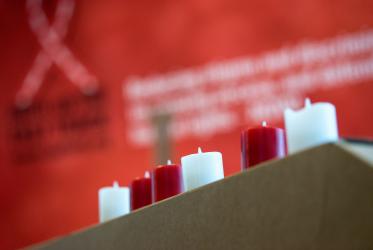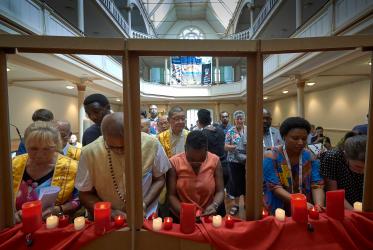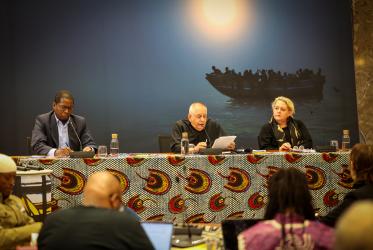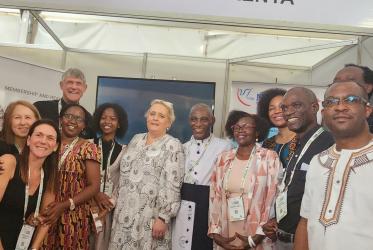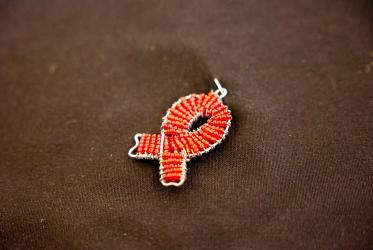By Sara Speicher*
A symbolic bridge, carefully constructed over a two-day interfaith conference, connects an interfaith networking zone with a space shared with the World Health Organization (WHO), UNAIDS and Unitaid at the Global Village of the International AIDS Conference 2018. Beyond the symbolism, faith-based organizations have been demonstrating efforts at “overcoming barriers, building bridges,” the theme of this 22nd conference addressing the global response to HIV.
The bridges and barriers, however, are not only between faith-based and secular efforts, but among faith groups themselves.
One of the interfaith efforts highlighted on all sides is the initiative “Leading by Example: Religious Leaders and HIV Testing” developed by the World Council of Churches – Ecumenical Advocacy Alliance (WCC-EAA).
Francesca Merico, HIV campaign coordinator for WCC-EAA, explained that the initiative was developed when it was apparent that 70 percent of people living with HIV didn’t even know about their status – an essential first step to treatment and support.
“Faith communities have to do something,” she says, “and religious leaders can lead by example and get themselves tested.”
Merico said so far 3,500 religious leaders are involved in the campaign, which asks the religious leaders, in addition to taking the test, to share their photo and a key message on testing through social media.
The leaders are also asked to put in place advocacy and information services for their community, said Merico, who works with the WHO to make sure the leaders have up-to-date information and guidelines.
Sr Elizabeth Vinyoh from Cameroon described how her community visits remote villages to educate on HIV. “With all the groups, we first sensitize them. Then we ask who wants to go for a test, and we as sisters go with them.”
They also offer support after the test. “You need to test – and you need to follow up,” she said.
Other religious leaders affirmed, “We don’t just want them to know their status, we want them to get treatment and support. So that is the richness of the faith response.”
Although religious leaders involved come from a diversity of faith traditions, many share common reactions to being involved in the initiative.
“They have said that it makes an impact, that they know better how it feels to be in the shoes of someone waiting for that result,” said Lyn van Rooyen from South Africa. “It creates solidarity and empathy.”
Overcoming stigma a continued challenge
Faith-based organizations and communities continue to be challenged to address the barrier of stigma and discrimination, in which religion is seen both as a cause and a solution.
The apparent contradiction is highlighted in a recent Emory University study in which people identified religious structures, beliefs, and individuals’ faith-inspired actions at times as stigmatizing and at other times as affirming and transformative.
This contradiction in perception and experience sometimes also prevents faith groups from speaking out together.
David Barstow, from the United States, is currently spearheading efforts for a “Common Voice” commitment, to find language all people of faith can affirm in responding to HIV and AIDS.
“I have been overwhelmed by the positive feedback, both conceptually and in terms of the words, and the diversity of the religious people giving feedback,” he said about the effort so far. “If we can get a positive response from both ends of the spectrum, we must be doing something right.”
And one of the common areas of agreement is to highlight to the public that HIV and AIDS has not gone away.
As UNAIDS Executive Director Michel Sidibé noted in a 24 July dialogue with faith groups, the greatest challenge is invisibility of HIV in the media and the general public.
“We broke the conspiracy of silence,” said Sidibé, “but now it is the conspiracy of complacency. We can win against AIDS but we are not there yet. We must still be a driving force for change.”
Building Bridges in the global HIV response (WCC press release of 25 July)
Access free high-resolution photos for download
Debunking myths and serving all: People on the move and HIV (press release of 23 July 2018)
"We just need to work together" - Children, Adolescents and HIV (press release of 22 July 2018)
Building bridges between the HIV and TB responses (press release of 22 July 2018)
“The materials are us” - Faith building bridges in the HIV response (press release of 21 July 2018)
Global Village - Faith Building Bridges Networking Zone, Day by Day (pdf)
*Sara Speicher is communication officer for the World Council of Churches.

